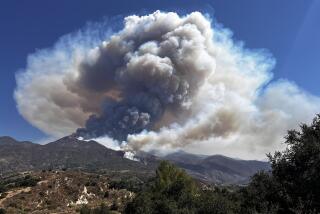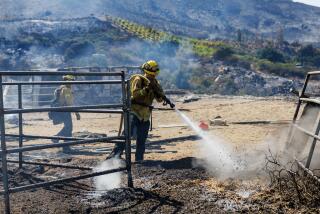The Every-Year War
- Share via
Like an aerial ballet, a giant red and white helicopter navigates a column of thick dark smoke, comes in low and drops a cascade of water onto the inferno. Another aircraft swoops down, releasing a trail of gooey, pink fire retardant that floats scarf-like across the front of the fire line.
On the ground, the scene is much more gritty.
A line of firefighters with shovels and hand tools scrapes away at vegetation waiting to feed an approaching wall of flame.
Outfitted in fire resistant pants and jacket, high-top boots, goggles and helmet, the typical firefighter is carrying 40 to 50 pounds of equipment along steep slopes in 100-plus temperatures.
That’s just to get to the fire. Then the fight begins.
“You are physically taxed when you get to the top of the hill. It’s an explosive type of activity. Your adrenaline is flowing. Pulling hoses under hot, dry conditions, even the ones in the best shape can be exhausted. When you add a 50- to 70-mph wind . . . you can be overwhelmed,” says Paul Hunter of the Orange County Fire Authority.
Orange County’s first major brush fire of the season scorched about 500 acres in San Clemente earlier this week.
And the forecast is not good.
Rainfall and humidity have been lower than normal, plant moisture is low and temperatures are high, Hunter said. And now the Santa Ana winds are due.
It’s then that the region’s fire danger skyrockets, and firefighters are put to a test of extremes.
More to Read
Sign up for Essential California
The most important California stories and recommendations in your inbox every morning.
You may occasionally receive promotional content from the Los Angeles Times.













